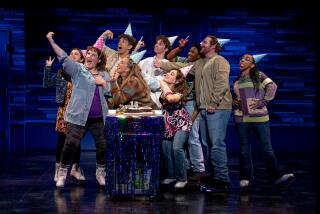LOS ANGELES THEATER FESTIVAL : A GIMMICKY âLA CENERENTOLAâ
Rossiniâs opera semi-buffa âLa Cenerentola,â a.k.a. âCinderella,â is a bel-canto delight--delicate, sophisticated, charming, often funny and often touching.
You wouldnât have guessed it Friday night at the Dorothy Chandler Pavilion, where the Music Center Opera offered a dull and heavy-handed perversion directed by Frank Corsaro.
The problem is simple. Corsaro doesnât trust Rossini or his librettist, Giacomo Ferretti. He doesnât listen to the music. He doesnât care much about the plot and the characters. He doesnât even seem to trust his audience.
Corsaro likes gimmicks, and he pastes them onto the action for easy laughs. When he isnât busy second-guessing the authors, he asks his somewhat helpless cast just to stand and sing. The result is a pesky network of gags punctuating a rather blank Rossini concert in costume.
Even the costumes are troublesome. The fussy designs of Franco Colavecchia place the fairy tale in a quaint mansion at the turn of the century--the current century. The inhabitants of this prosaic operetta milieu thus become bland Edwardian stereotypes. Donât ask why.
The evening begins ominously. Theorizing that no audience could sit through a Rossini overture without visual diversion, Corsaro turns to the cliche of illustrative pantomime. He distracts us with the plight of a beguiling little mock-Alice without a Wonderland (who deserves program credit but receives none). For some reason, the child is banished by her cruel teachers and schoolmates to an empty mansion.
There, while Rossini whips up the most delicious of crescendos, she dreams up stodgy visions of Cinderella, obviously a kindred spirit. She also arouses an unexpected trio of unamusing mimes who function, in turn, as live puppets, props and scenery-movers.
The plot thus unfolds, creakily, as a story within a story, cluttered with extraneous characters. The dream premise is dropped, however, long before the final curtain. Poor Alice never gets to wake up.
The director and his scenic collaborator frost their fallen cake with tedious pleas for applause. While Rossini clearly mimics the pompous footsteps of the false prince at his entrance, Corsaro rolls on a mock-pensive baritone perched on a wheeled throne.
This contradicts the mood, music and text. It is very much in keeping, however, with a narrative scheme that seems primarily concerned with having various cast members ride either a wooden horse or a cut-out antique car that masquerades as Cinderellaâs carriage.
Other important innovations include the shooting of a stuffed bird that drops from the wings, the serving of an enormous pizza, the intrusions of the ubiquitous doll-servants and the scene--sorry, wrong Rossini--in which the baritone sloppily barbers the basso.
Corsaro is too busy with trivia to tell us much about the real protagonist, her innate yearnings, her dauntless kindness, her ability to grow from pitiful waif to glamorous princess to generous, loving woman. Cinderella, like all the participants in this trite exercise, is just a singing stick.
Some of the sticks, not incidentally, sing better than others.
Under happier circumstances, one would lament the heavy cuts sanctioned by director and conductor. In this case, one has to be grateful. As it was, the three-hour ordeal dragged on as if Rossini had somehow managed to fuse âParsifalâ with âGotterdammerung.â
Sir Neville Marriner did not stress rhythmic propulsion in the pit, and he failed to enforce ideal communication with the stage. Nevertheless, with his inherent sensitivity to the need for grace, transparent textures and lyric point, he was able at least to hint at some of the elegance ignored by his theatrical collaborators.
Frederica von Stade may be the worldâs finest Cherubino. She is an ideal Melisande--ethereal yet sensuous--and a most discerning recitalist. Rossiniâs mercurial heroine, however, does not bring out the best in her.
She sings the plaintive music very sweetly. She sings the ornamented music with refined accuracy. What she lacks is the magnetism that defines Cenerentola as a potential princess from the outset, not to mention shear bravura glitter.
Dalmacio Gonzalez, her handsome prince, negotiates the ornate bel-canto stratosphere better than most contemporary tenorinos can. That isnât saying much.
Alan Titus, whose baritone has swollen to Verdian proportions, isnât particularly comfortable with the agility and wit of Dandini (or with his dandy striped suit). Francois Loup reduces Magnifico to a restrained clown.
John Del Carlo looms in benign, empty poses as Alidoro and finds the restored aria something of a basso trial. Jeralyn Refeld and Stephanie Vlahos are attractive but dramatically vapid and musically strident as the nasty, virtually identical sisters.
The Music Center Opera opened its season with a problematic hand-me-down âBohemeâ staged by Jean-Pierre Ponnelle. It might have been wise to give the Puccini to Corsaro and borrow Ponnelleâs definitive âCenerentolaâ instead.
More to Read
The biggest entertainment stories
Get our big stories about Hollywood, film, television, music, arts, culture and more right in your inbox as soon as they publish.
You may occasionally receive promotional content from the Los Angeles Times.










